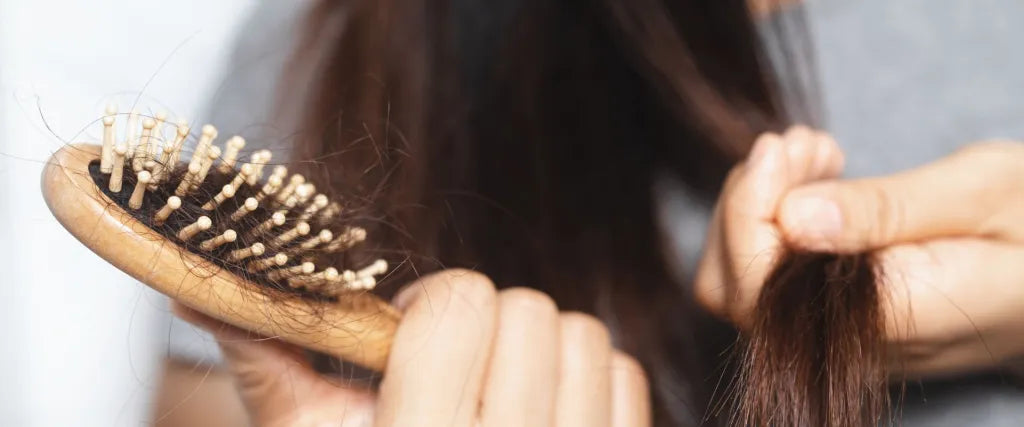
Hair Loss Is More Common Than You Think—But So Are Misleading Solutions
- Millions of people experience hair thinning or loss, from mild shedding to pattern baldness.
- The market is full of products with bold promises, but not all are supported by science.
- Knowing what actually works versus what is overrated is key to protecting your hair and your wallet.
Shampoos & Conditioners: A Nice Start, But Don’t Expect Regrowth
- Many people first try shampoos labeled “volumizing” or “fortifying.”
- These products may improve scalp hygiene and add temporary fullness.
- However, shampoos and conditioners are rinse-off products—they don’t stay long enough to deliver meaningful active ingredients to follicles.
- They can still play a supportive role when paired with targeted treatments.
Physical Tools: The Underrated Ally in Your Hair Routine
- Scalp massagers—manual or applicator-based—help improve blood circulation to follicles.
- Better circulation nourishes follicles and encourages growth.
- When paired with a nutrient-dense scalp serum, results are amplified.
- Think of it like prepping the soil before planting seeds—it makes treatments more effective.
Hair Serums: Precision Care, Right at the Roots
1. Unlike shampoos, serums stay on the scalp and deliver active ingredients directly.
2. BIGVITA’s Scalp Serum + supports follicle health and helps minimize miniaturization.
3. Typical serum ingredients include caffeine, peptides, and botanical extracts, which:
- Nourish follicles
- Reduce inflammation
- Extend the hair growth cycle
4. Scalp Serum + features AnaGain™, which helps prolong the growth phase and shorten the shedding phase.
5. A patented massaging applicator improves blood flow and enhances results.
6. Consistent use can reinforce hair strength and density.
Minoxidil: Growth With Limitations
1. Minoxidil increases blood flow to the scalp and stimulates the growth (anagen) phase.
2. Results may take 3–6 months to appear.
3. Stopping treatment often causes regression.
4. Potential side effects:
- Scalp irritation
- Rarely, unwanted facial hair growth
5. Despite limitations, Minoxidil remains a proven treatment option.
Finasteride: Effective but Controversial
1. Finasteride (Propecia) is FDA-approved and taken orally.
2. It works by blocking DHT, the hormone linked to male pattern baldness.
3. Benefits: highly effective in preventing further hair loss.
4. Risks: some users report persistent side effects, such as:
- Sexual dysfunction
- Mood changes
5. A CBC News investigation highlighted concerns about long-term safety data.
6. Consultation with a healthcare provider is essential before use.
Hair Supplements: Nutritional Support for Stronger Strands
1. Internal health strongly affects hair growth and strength.
2. Supplements can fill gaps caused by poor diet or nutrient deficiencies.
3. BIGVITA’s Hair + formula includes:
- AnaGain™ Nu (the ingestible version of AnaGain™)
- Biotin
- Amino acids
- Black sesame seed extract
4. Yüth™ (spermidine) supports hair health by:
- Upregulating keratin production
- Supporting autophagy (cellular renewal)
- Strengthening the follicle root environment, especially with age
What Actually Works?
- Use a scalp massager with a high-quality serum for targeted follicle support.
- Consider Minoxidil or Finasteride—but only with caution and medical guidance.
- Support internal hair health with evidence-based supplements like Hair +.
Don’t Wait for Regrowth—Act Now
1. The earlier you act, the more hair you can preserve.
2. A strong routine should be:
- Consistent
- Evidence-backed
- Customized to your needs
References
1. Compound Solutions. (2024). Yüth clinical research – Internal study on nail and hair health (Rev II). Compound Solutions Inc.
2. CBC News. (2023, November 29). Hair-loss drug finasteride can cause persistent sexual side-effects, men say. https://www.cbc.ca/news/health/hair-loss-drug-finasteride-side-effects-1.7483898
3. Gupta, A. K., & Charrette, A. (2015). Topical minoxidil: Systematic review and meta-analysis of its use in androgenetic alopecia. Journal of Dermatological Treatment, 26(6), 555–563. https://doi.org/10.3109/09546634.2015.1021643